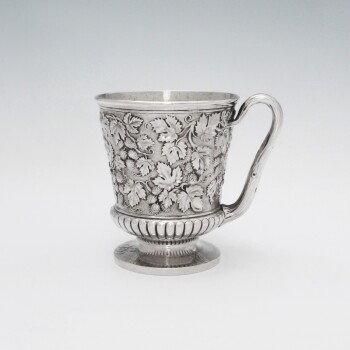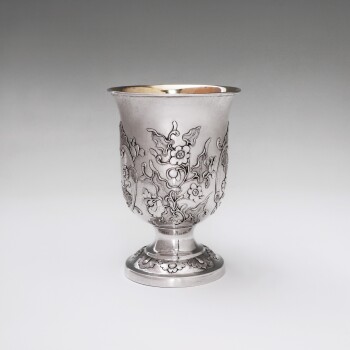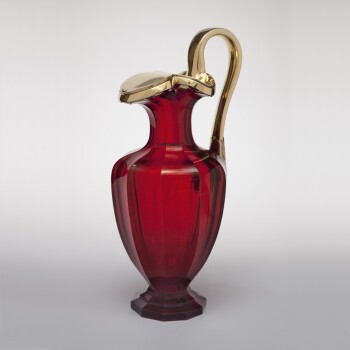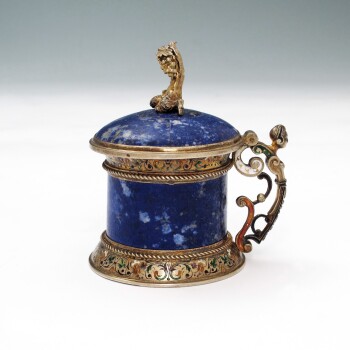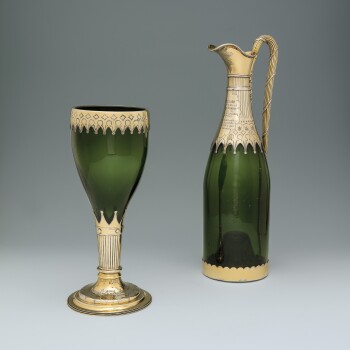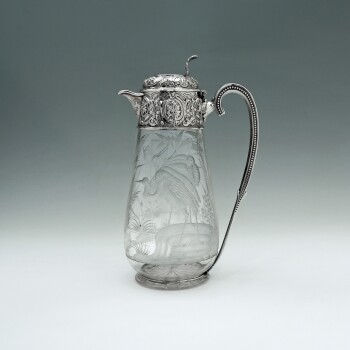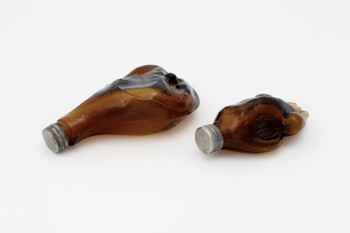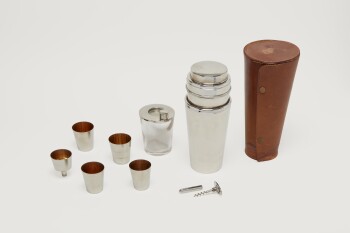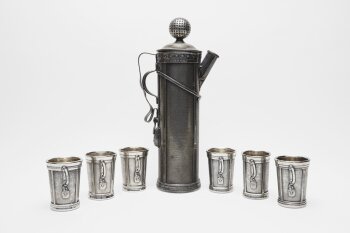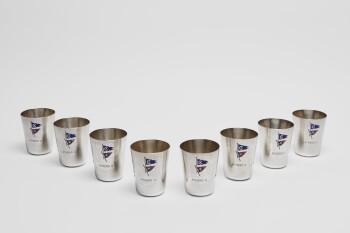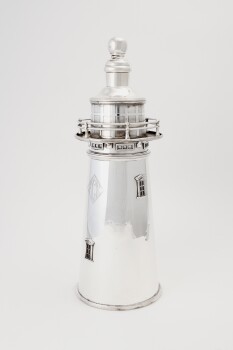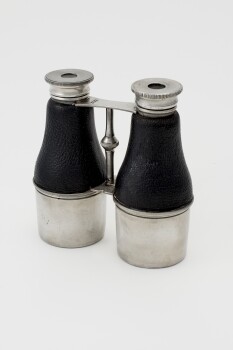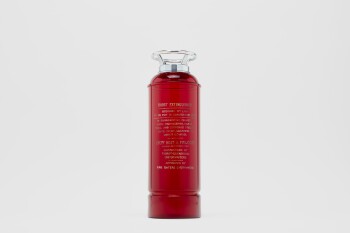T o commemorate the 100th anniversary of Prohibition in America, Sotheby’s has partnered with Alan Bedwell, owner of Foundwell, to present a curated selection of antique and vintage items in celebration of the beauty, ingenuity and design of barware.
With its ratification in 1920, the 18th Amendment to the Constitution of the United States banned the sale, transportation and manufacturing of liquors. Prohibition, however, proved difficult to enforce, and the United States entered a period notorious for bootlegging, speakeasies and other types of crime surrounding the production, smuggling and distribution of liquor.
- 1826-27
- 1830s
- 1847
- 1851
- 1855
- 1873
- 1876
- 1881
- 1913
- 1917
- 1919
- 1920
- 1920s
- 1929
- 1931
- 1933
-
 1826-27Paul Storr, London, A George IV Silver Child’s Mug. Estimate $2,000–3,000.
1826-27Paul Storr, London, A George IV Silver Child’s Mug. Estimate $2,000–3,000.
Co-Founder of the American Temperance society, Reverend Lyman Beecher, gives sermons on intemperance, preaching against the evils of alcohol. These were printed and distributed around the U.S. and Europe. -
 1830sA Gold-Mounted Rock Crystal Goblet & Cover. Estimate $15,000–25,000.
1830sA Gold-Mounted Rock Crystal Goblet & Cover. Estimate $15,000–25,000.
The first Temperance movements begin advocating abstinence from alcohol. -
 1847Khecheong, Canton, A Chinese Export Silver Goblet. Estimate $2,000–3,000.
1847Khecheong, Canton, A Chinese Export Silver Goblet. Estimate $2,000–3,000.
Maine passes the 15 Gallon Law, banning the sale of alcohol in amounts smaller than 15 gallons. -
 1851Charles T. & George Fox, London, A Victorian Silver-Gilt Mounted Ruby Glass Claret Jug. Estimate $5,000–8,000.
1851Charles T. & George Fox, London, A Victorian Silver-Gilt Mounted Ruby Glass Claret Jug. Estimate $5,000–8,000.
The Maine Law is passed, banning the production and sale of alcohol except for medicinal uses. The law was later repealed in 1856. -
 1855Aldwinkle & Slater, London, A Victorian Silver-Gilt Mounted Claret Jug. Estimate $4,000–6,000.
1855Aldwinkle & Slater, London, A Victorian Silver-Gilt Mounted Claret Jug. Estimate $4,000–6,000.
12 more states ban the production and sale of alcoholic beverages, leading to increased tension between ‘dry’ and ‘wet’ states. -
 1873Hermann Ratzersdorfer, Vienna, A Miniature Silver-Gilt, Enamel and Hardstone Austrian Tankard. Estimate $5,000–7,000.
1873Hermann Ratzersdorfer, Vienna, A Miniature Silver-Gilt, Enamel and Hardstone Austrian Tankard. Estimate $5,000–7,000.
The Women’s Christian Temperance Union is founded. -
 1876Rupert Favell, London, A Victorian Silver-Mounted Claret Jug and Goblet. Estimate $20,000–30,000.
1876Rupert Favell, London, A Victorian Silver-Mounted Claret Jug and Goblet. Estimate $20,000–30,000.
The Prohibition Party is formed. -
 1881W. & G. Sissons, Sheffield, A Victorian Silver-Mounted Claret Jug. Estimate $3,000–5,000
1881W. & G. Sissons, Sheffield, A Victorian Silver-Mounted Claret Jug. Estimate $3,000–5,000
Kansas makes prohibition part of its state Constitution. Activists enforce the law with demonstrations and the destruction of bottles of liquor. -
 Steven_Director1913Two Molded Glass Flasks. Estimate $400–600.
Steven_Director1913Two Molded Glass Flasks. Estimate $400–600.
Members of the Women’s Christian Temperance Movement and the Anti-Saloon League march on Washington D.C. to demand a prohibition amendment to the U.S. Constitution. -
 1917T.G. Hawkes & Co., Corning, New York, A Pair of Silver-Mounted Cut-Glass Decanters. Estimate $3,000–5,000.
1917T.G. Hawkes & Co., Corning, New York, A Pair of Silver-Mounted Cut-Glass Decanters. Estimate $3,000–5,000.
The National Prohibition Act, also known as the Volstead Act, is passed by the U.S. Senate, prohibiting ‘intoxicating beverages’ i.e. any drink containing more than 0.5% alcohol. -
 1919J.A. Henckles, Solingen, A German Chrome-Plated Art Deco Travel Cocktail Set. Estimate $900–1,400.
1919J.A. Henckles, Solingen, A German Chrome-Plated Art Deco Travel Cocktail Set. Estimate $900–1,400.
The 18th Amendment to the U.S. Constitution is ratified in January banning the production, transportation and sale of alcoholic beverages. The Volstead Act is passed by the U.S. Congress and guidelines for enforcement are established. -
 1920An American Silver-Plated Golf-Themed Cocktail Set. Estimate $5,500–7,500
1920An American Silver-Plated Golf-Themed Cocktail Set. Estimate $5,500–7,500
The Volstead Act comes into effect. -
 1920sA Set of Eight American Silver Yachting Cups. Estimate $3,500–5,500.
1920sA Set of Eight American Silver Yachting Cups. Estimate $3,500–5,500.
A large black market distributing and selling alcohol develops around the US. Bootlegging gangs led by figures such as Al Capone increase in number. -
 Steven_Director1929An American Silver-Plated ‘Boston Lighthouse’ Cocktail Shaker. Estimate $3,000–5,000.
Steven_Director1929An American Silver-Plated ‘Boston Lighthouse’ Cocktail Shaker. Estimate $3,000–5,000.
Nearly every U.S. City sees a rise in gang violence. Prohibition Agent Elliot Ness begins to tackle violators of Prohibition in earnest. In October the stock market crashes, marking the start of the Great Depression. -
 Steven_Director1931James Dixon & Sons, Sheffield, An English Silver-Plated Binocular-Form Double Spirit Flask. Estimate $800–1,200.
Steven_Director1931James Dixon & Sons, Sheffield, An English Silver-Plated Binocular-Form Double Spirit Flask. Estimate $800–1,200.
In his Republican presidential nomination acceptance speech, Herbert Hoover discusses the ills of Prohibition and the need for its end. -
 1933An American Art Deco Ruby Red Glass Cocktail Shaker. Estimate $900–1,400.
1933An American Art Deco Ruby Red Glass Cocktail Shaker. Estimate $900–1,400.
The US Congress proposes an amendment to the Constitution that would end prohibition. Newly elected president Franklin D. Roosevelt signs the Cullen-Harrison Act, legalizing the manufacture and sale of certain alcoholic products. In December Prohibition is officially repealed by the passage of the 21st amendment to the U.S. Constitution.
It was not until 1933 that the United States Congress adopted a new amendment – the 21st – to repeal the 18th, bringing an end to Prohibition. Still, the legacy of Prohibition remained and left a lasting impact on design, music and consumption, which in turn caused a reverence for alcohol to develop across the United States.
Sotheby’s is delighted to partner with Mr. Bedwell to offer this selected group of bar essentials, which showcase pieces designed and manufactured before, during and after this monumental time in American history.

Sale curator Alan Bedwell, owner of the dealership Foundwell, selects his favorite pieces.
An American Silver-Plated Penguin-Form Cocktail Shaker
Estimate $1,000–1,500
This iconic piece of barware is not only visually appealing and splendidly stylish, it is useful, simply made, easy to use and clean making it the perfect cocktail shaker. Plus it is large and a great piece for entertaining. Made by renowned American jewelry and home goods manufacturer; Napier. It was designed by Emile Schulke in 1936, shortly after the end of Prohibition and at the height of the Jazz Age and who doesn't love a penguin, after all!
An American Silver-Plated Golf-Themed Cocktail Set
Estimate $5,500–7,500
Perhaps the most important cocktail shaker to have ever been designed. A watershed moment for barware, this was the figural piece to have ever been made. The fact it was conceived and manufactured in America in 1925, at the onset of Prohibition, in itself is remarkable. Add to that it began a trend that lives on nearly one hundred years later is testament to the genius of Mr Berry for designing it. The shaker is accompanied by the equally rare matching six golf bag themed cups, it is a must for any serious collector. Along with being golf themed it ticks a lot of boxes for those into the sport. As every golfer knows, after a perfectly good walk spoiled, there is always the 19th hole, and what better way to prepare the reward.
Hukin & Heath, Birmingham, Two Matching English Silver-Mounted Cut-Glass Decanters
Estimate $5,000–7,000
This matching pair of decanters, although made well before Prohibition in England, are the epitome of elegance, quality and make for a focal point for any serious home bar. When I began buying and selling antiques to have a single, let alone a pair of these, in your inventory meant you really had something quite special. As a decanter, with the large, simplistic bodies and highly cut faceted stoppers, they are impressive. Add to this that the sterling silver necks of both contain locks make them a 'must have' for any serious liquor aficionado. They were designed at time where staff were present in most affluent homes, and the suspicious patriarch of the house may want to keep his prized brandy or whisky away from any unwanted attention. Being it precocious teenage children, or the butler. This was the perfect, and tasteful way to do so.
Set of Six American Silver Cocktail Spoons
Estimate $600–800
These are fantastic. Especially at a time where we are all more conscious and accountable for our carbon footprints. Straws are one of those very disposable, but much needed items in a home bar. This sterling silver set doubles as both a straw and a mixer. They really help muddle your Mojito while not adding to the plastic pollution issues in the world but adding a little sophistication at the same time.
James Dixon & Sons, Sheffield, An English Silver-Plated Binocular-Form Double Spirit Flask
Estimate $800–1,200
Of all the pieces here, this is one that I personally love. To take a fairly common object and completely change its purpose for something else, while retaining the design integrity is fascinating for me. Fabulously made, the way each lens side could contain a different drink, or potentially a mixer is brilliant. The fact that the lens caps come off the other end for use as two cups highlights what a wonderful and civil world it used to be. Above and beyond this, they are exceptionally rare! I could see myself sneaking these into a football game and not getting caught!
New York City Bartenders Share Their Favorite Cocktails to Enjoy at Home
In honor of our auction, Prohibition in America | 100 Years, we invited four of our favorite NYC-based bartenders to mix us up their favorite cocktails, tell us their favorite lots from the auction and discuss which charities they're supporting right now. Watch them work their magic – then learn the recipe to replicate the drink yourself.

These objects form a part of history; some were created during the Prohibition era and others were fabricated to celebrate its end in style.

Don’t be fooled by appearances – these seemingly innocent and ornamental items are also highly practical (if you’re in need of a sneaky tipple, that is).

It’s all about the details – whether you’re preparing that perfect cocktail or sipping your favorite spirit, don’t forget to accessorize.

The sale features a range of beautifully constructed drinking accoutrements from the 19th century – for those who prefer to indulge luxuriously.
